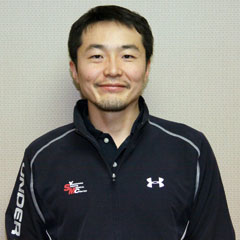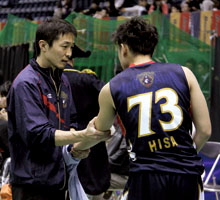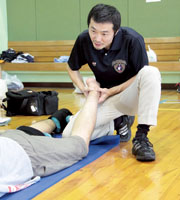SPORTS YOKOHAMA Vol.36 : Feature(3/5)

A physical therapist at the Yokohama Sports Medical Center, Mr. Tatsuya Tamaki now serves as the team trainer for Yokohama B-Corsairs of the bj League (Japanese professional basketball league) as well. The job of a team trainer is to keep players in the best possible condition in terms of both health and performance. Mr. Tamaki supports players on the medical front and works in conjunction with Dr. Shimizu.

Tatsuya Tamaki, a physical therapist
at the Yokohama Sports Medical Center

Tamaki attends the games
and treats injured players. 
As the team trainer, Mr. Tamaki travels
with the team of Yokohama B-Corsairs.
Liaison between the doctor and players
The trainer tells an injured player the doctor’s instructions and gives him advice on rehabilitation and training based on those instructions and the condition of the injury. We serve as, so to speak, a liaison between the doctor and players, and our job is to provide injured players with a path to return to competition.
Also, to prevent injury due to fatigue from successive games, we treat joint distortion and give massage. In the last off-season, we provided each player with an individual training program aimed at injury prevention. Probably because the players exercised these programs, we haven’t seen any player get injured due to fatigue so far in this season. We trainers predict all possible situations and always think about preventing injury by taking necessary measures in advance.
While taking care of an injury that has been sustained is an important part of the job, I think it’s particularly vital not to overlook signs of injury and to prevent players from getting hurt.
I sometimes feel sorry when the measure that we have taken for an injured player does not seem to be as effective as it should be or when we cannot fully live up to the hope of a player who stays in the games despite pain.
Suggestions on Rehabilitation Training for Players
When an injured player achieves his goal by doing the rehabilitation training I suggested to him, I feel glad as if I’m the one who has done it. My policy is to suggest several training options to the player and have him choose the one he likes, rather than forcing the player to do a fixed set of rehabilitation exercises. I think that, when the player chooses what to do from suggested options based on an understanding of each of those options, he is more likely to acquire rehabilitation skills and continue to do rehab training. Of course, I offer additional advice based on the progress of the rehabilitation. As the player gets better, we move forward step by step toward the return to competition.
Medical Exercise Course (MEC)
At the Yokohama Sports Medical Center, Mr. Tamaki supervises the MEC programs for knee and waist injuries. The MEC is intended for those whose medical or orthopedic problem is expected to be improved with exercise therapy. It is designed to provide a patient with a type of exercise appropriate for his or her age and medical condition and encourage the patient to engage in voluntary training or participate in a sports class.
At the Yokohama Sports Medical Center, patients are invited to take the MEC as necessary after their visit to a physician or orthopedic surgeon under the direction of the doctor in charge. In order to participate in the MEC, you need to visit the Yokohama Sports Medical Center clinic on a regular basis because the decision as to whether exercise is allowed and the content of the exercise program may change depending on your medical condition.
For more information, call the Yokohama Sports Medical Center at 045-477-5050.

A physical therapist at the Yokohama Sports Medical Center, Mr. Tatsuya Tamaki now serves as the team trainer for Yokohama B-Corsairs of the bj League (Japanese professional basketball league) as well. The job of a team trainer is to keep players in the best possible condition in terms of both health and performance. Mr. Tamaki supports players on the medical front and works in conjunction with Dr. Shimizu.

Tatsuya Tamaki, a physical therapist
at the Yokohama Sports Medical Center

Tamaki attends the games
and treats injured players. 
As the team trainer, Mr. Tamaki travels
with the team of Yokohama B-Corsairs.
Liaison between the doctor and players
The trainer tells an injured player the doctor’s instructions and gives him advice on rehabilitation and training based on those instructions and the condition of the injury. We serve as, so to speak, a liaison between the doctor and players, and our job is to provide injured players with a path to return to competition.
Also, to prevent injury due to fatigue from successive games, we treat joint distortion and give massage. In the last off-season, we provided each player with an individual training program aimed at injury prevention. Probably because the players exercised these programs, we haven’t seen any player get injured due to fatigue so far in this season. We trainers predict all possible situations and always think about preventing injury by taking necessary measures in advance.
While taking care of an injury that has been sustained is an important part of the job, I think it’s particularly vital not to overlook signs of injury and to prevent players from getting hurt.
I sometimes feel sorry when the measure that we have taken for an injured player does not seem to be as effective as it should be or when we cannot fully live up to the hope of a player who stays in the games despite pain.
Suggestions on Rehabilitation Training for Players
When an injured player achieves his goal by doing the rehabilitation training I suggested to him, I feel glad as if I’m the one who has done it. My policy is to suggest several training options to the player and have him choose the one he likes, rather than forcing the player to do a fixed set of rehabilitation exercises. I think that, when the player chooses what to do from suggested options based on an understanding of each of those options, he is more likely to acquire rehabilitation skills and continue to do rehab training. Of course, I offer additional advice based on the progress of the rehabilitation. As the player gets better, we move forward step by step toward the return to competition.
Medical Exercise Course (MEC)
At the Yokohama Sports Medical Center, Mr. Tamaki supervises the MEC programs for knee and waist injuries. The MEC is intended for those whose medical or orthopedic problem is expected to be improved with exercise therapy. It is designed to provide a patient with a type of exercise appropriate for his or her age and medical condition and encourage the patient to engage in voluntary training or participate in a sports class.
At the Yokohama Sports Medical Center, patients are invited to take the MEC as necessary after their visit to a physician or orthopedic surgeon under the direction of the doctor in charge. In order to participate in the MEC, you need to visit the Yokohama Sports Medical Center clinic on a regular basis because the decision as to whether exercise is allowed and the content of the exercise program may change depending on your medical condition.
For more information, call the Yokohama Sports Medical Center at 045-477-5050.
 ハマスポ
ハマスポ
 お知らせ&トピックス
お知らせ&トピックス ページトップへ戻る
ページトップへ戻る ページトップへ戻る
ページトップへ戻る

